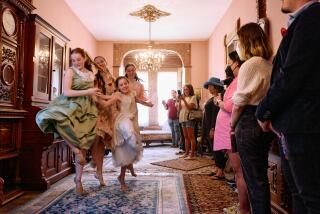Homeless Man Remembers His Glory Days in Ballet
- Share via
NEW YORK — Arthur Bell, a 71-year-old man, was found homeless and disoriented on a Brooklyn street last month, barely standing, his feet frozen. He told paramedics that he was once a ballet dancer in Paris.
“And they went, ‘Yeah, yeah, yeah,’ ” recalled social worker Maria Mackin. Bell’s medical chart, after all, noted possible signs of dementia.
But during the days that followed, Bell would tell Mackin tales of Paris and London, Frederick Ashton, Margot Fonteyn, Olga Preobrajenskaya, Katherine Dunham and James Baldwin.
“He started telling me things that only someone who was really in the dance world would know. And I thought, ‘This is not dementia,’ ” said Mackin, who happened to have been a ballet photographer at one time. She also saw that Bell was “incredibly graceful . . . slender, sleek.”
The accuracy, the richness of detail and the clarity with which he spoke led her to the New York Library for the Performing Arts at Lincoln Center.
Bell’s story checked out.
He had been a pioneering black ballet dancer. Though he was no star, he left his artistic mark on the 1940s and ‘50s, “when there was no place for African-Americans in classical ballet,” said Madeleine Nichols, curator of the dance collection at the library.
Bell worked odd jobs after his dance career ended, but can’t remember how he wound up on the street, where he had been living for months in the dead of winter. His last address was a men’s shelter. He would have been sent back there had Mackin not intervened.
Now he’s in a nursing home, recuperating from frostbite on his feet and legs. Slowly, he’s learning to walk again with a cane. He uses a wheelchair most of the time.
“I convinced them that he needed a higher level of care,” Mackin said. “I said, ‘This is a guy who was a pioneer in the dance world. He’s special; he’s an important part of African-American culture. We should go out of our way to help him.’ ”
Before she became a social worker, Mackin was a photographer for Capezio, the dance shoe company. She took photos of dance greats such as Rudolf Nureyev and Bob Fosse.
When Bell was rescued off the street, “the very first thing I asked was, ‘Do you have Medicare?’ ” Mackin recalled. “And he said, ‘Oh, I’m not really sure. We didn’t have to worry about these things when I lived in Paris and London; it’s a different medical system.’ And I thought, oh, this is a very sophisticated man. That was an awakening from my usual clients.
“I asked, ‘What were you doing in Paris?’ ”
And his story began to unfold.
“I was absolutely thrilled,” Mackin said. “I thought, oh my God, this is incredible, if this is true. And I really believed it was true and that the world had let this man slip through the cracks.”
Bell speaks of dance with a lucid passion that awakens his frail, 5-foot-11 body. Sitting in a wrinkled bathrobe, he arches his long neck and uses his long fingers to punctuate his remarks with lively elegance. The muscles in his legs are still sculptured.
The eldest of a Florida preacher’s nine children, Bell finished high school and got on a bus to New York. He quickly found a job in the garment district and started taking dance classes with Dunham.
In the early ‘50s he moved to Paris, where he said he lived in the same rooming house as Baldwin, the writer. He danced with the Ballets de la Tour Eiffel while studying with Preobrajenskaya, the retired Russian ballerina.
In 1950, Ashton, the great British choreographer, chose him as a guest soloist in the New York City Ballet’s world premiere of “Illuminations.”
Bell returned to New York in the ‘60s, forced to give up his career as he approached 40. His life slid away.
Bell, who receives $400 a month in Social Security, is waiting for his Medicaid application to be processed and wants to move to “somewhere where I could be near the theater most of the time.” He also wants to establish a scholarship fund for struggling young minority dancers.
Not being able to dance anymore doesn’t trouble him, he said, “because when you love something, the love for it just goes beyond anything. Dancing is in my soul.”
Mackin and her husband visit Bell twice a week.
“It make you think about the judgments you make--like reading the chart,” she said. “We have to listen to what people say instead of reading charts.”
More to Read
Sign up for Essential California
The most important California stories and recommendations in your inbox every morning.
You may occasionally receive promotional content from the Los Angeles Times.










